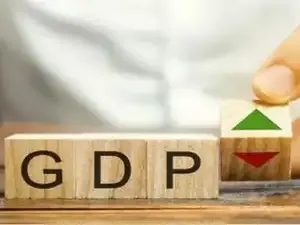India Ratings & Research (Ind-Ra) has projected India’s GDP to expand by 7.2% in the second quarter (July–September) of FY26, driven primarily by strong private consumption and a resilient services sector.
The Indian economy had recorded a 5.6% growth in Q2 of FY25, while it clocked 7.8% growth in the April–June quarter of the current fiscal, the fastest pace in five quarters. The National Statistical Office (NSO) is scheduled to release the official GDP numbers for Q2 FY26 on November 28.
In its latest assessment, Ind-Ra said, “From the demand side, private consumption is a leading growth driver due to steady real income growth both in upper- and lower-income households.”
According to PTI quoting Paras Jasrai, Economist & Associate Director at Ind-Ra, “The resilient services sector along with the favourable base-led goods exports growth in the manufacturing sector propelled GDP growth from the supply side during Q2 FY26.”
The report highlighted that the economy has weathered global headwinds better than expected, supported by robust domestic demand. It noted that retail inflation has eased faster than anticipated by both the agency and the Reserve Bank of India (RBI), helping boost real wages and consumption.
However, Ind-Ra cautioned that nominal GDP growth may have dipped below 8% year-on-year in Q2 FY26, which could impact government tax collections. “The real GDP growth looks stronger as lower input costs have provided some succour to the growth momentum, despite heightened global economic uncertainty and volatility. Nevertheless, continued weakening nominal GDP growth would be of greater concern as it may complicate the fiscal arithmetic,” the agency said.
Ind-Ra estimates private consumption to have grown 8% year-on-year in Q2 FY26, compared to 7% in Q1 and 6.4% in Q2 FY25. A favourable base effect, record low inflation, and steady rural wage growth are seen as major contributors to this uptick.
“The consumption demand was also supported by the income tax cuts as announced in the FY26 budget. The private consumption would have grown at an even higher pace, had there been no deferral of buying decisions due to the GST rate rationalisation,” Ind-Ra added.
On the investment front, the agency said demand grew 7.5% year-on-year during Q2 FY26, with steady government capital expenditure playing a key role in sustaining momentum amid global uncertainty.
With inputs from PTI
The Indian economy had recorded a 5.6% growth in Q2 of FY25, while it clocked 7.8% growth in the April–June quarter of the current fiscal, the fastest pace in five quarters. The National Statistical Office (NSO) is scheduled to release the official GDP numbers for Q2 FY26 on November 28.
In its latest assessment, Ind-Ra said, “From the demand side, private consumption is a leading growth driver due to steady real income growth both in upper- and lower-income households.”
According to PTI quoting Paras Jasrai, Economist & Associate Director at Ind-Ra, “The resilient services sector along with the favourable base-led goods exports growth in the manufacturing sector propelled GDP growth from the supply side during Q2 FY26.”
The report highlighted that the economy has weathered global headwinds better than expected, supported by robust domestic demand. It noted that retail inflation has eased faster than anticipated by both the agency and the Reserve Bank of India (RBI), helping boost real wages and consumption.
However, Ind-Ra cautioned that nominal GDP growth may have dipped below 8% year-on-year in Q2 FY26, which could impact government tax collections. “The real GDP growth looks stronger as lower input costs have provided some succour to the growth momentum, despite heightened global economic uncertainty and volatility. Nevertheless, continued weakening nominal GDP growth would be of greater concern as it may complicate the fiscal arithmetic,” the agency said.
Ind-Ra estimates private consumption to have grown 8% year-on-year in Q2 FY26, compared to 7% in Q1 and 6.4% in Q2 FY25. A favourable base effect, record low inflation, and steady rural wage growth are seen as major contributors to this uptick.
“The consumption demand was also supported by the income tax cuts as announced in the FY26 budget. The private consumption would have grown at an even higher pace, had there been no deferral of buying decisions due to the GST rate rationalisation,” Ind-Ra added.
On the investment front, the agency said demand grew 7.5% year-on-year during Q2 FY26, with steady government capital expenditure playing a key role in sustaining momentum amid global uncertainty.
With inputs from PTI





